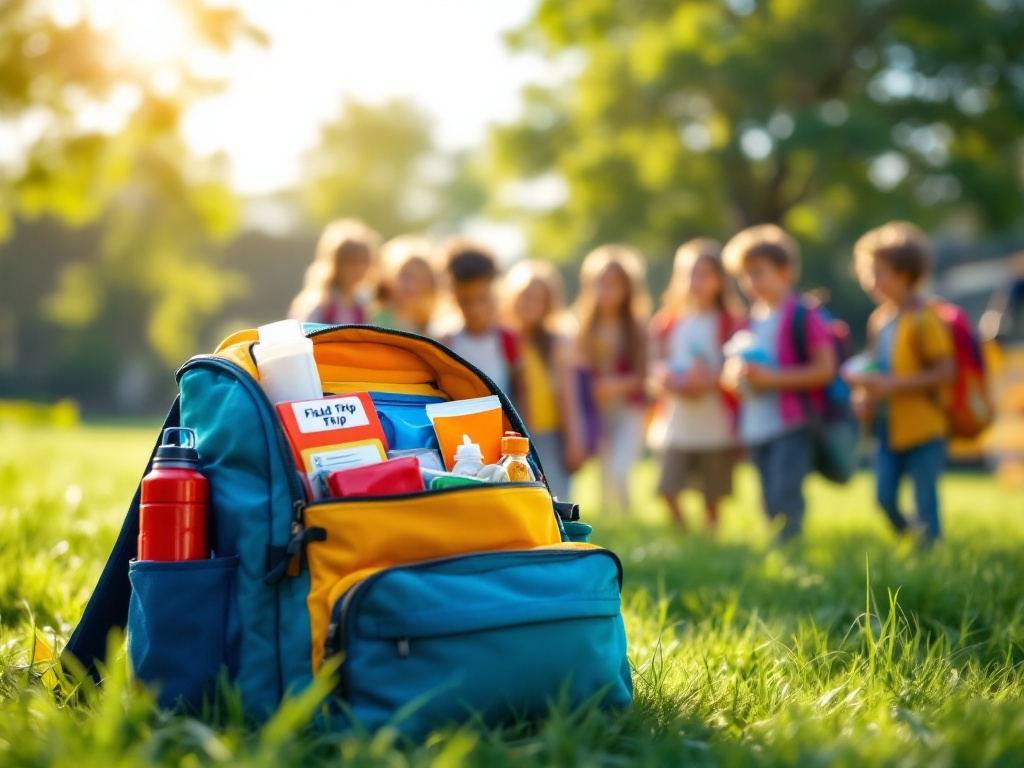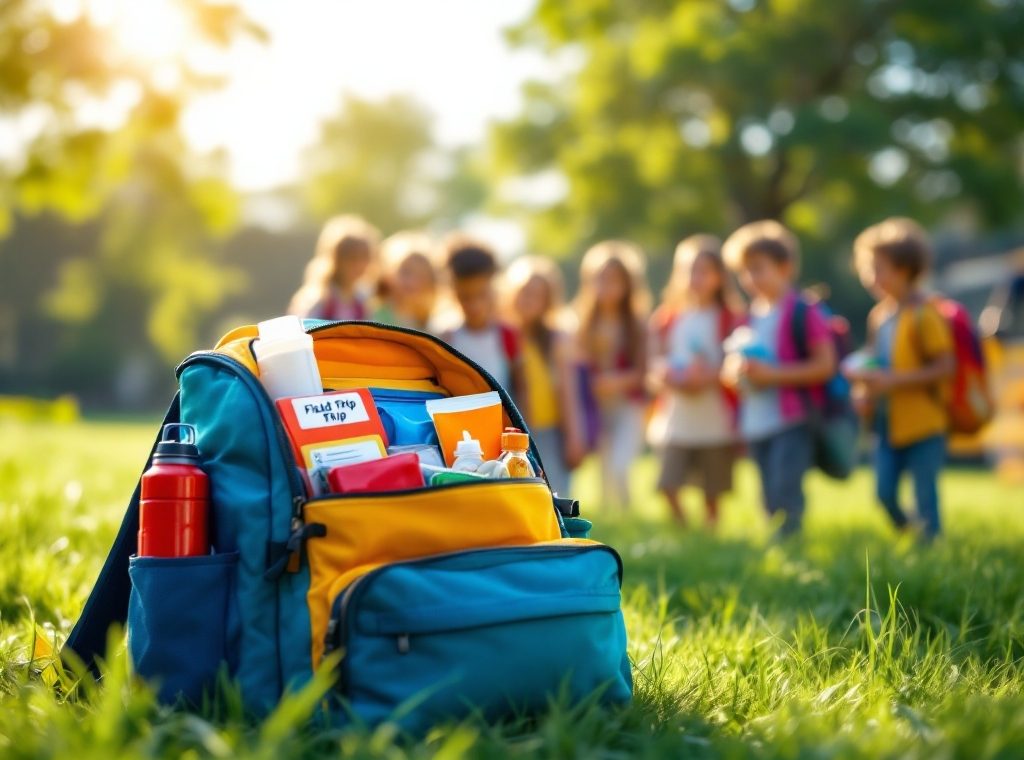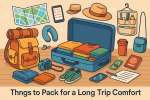What to Pack for a Field Trip? A Guide for Kids, Parents and Teachers
Planning a field trip? Ensure a smooth and enriching experience by packing smart! This guide covers essential items for students and chaperones, from safety must-haves like first-aid kits and emergency contacts to comfort items like appropriate clothing and healthy snacks. Learn how to pack efficiently with checklists, choose the right water bottle, and handle potential motion sickness. Prepare now for a successful and memorable field trip!
Important information

- Pack a first-aid kit with essentials like bandages, antiseptic wipes, and any personal medications.
- Dress comfortably in weather-appropriate clothes and sturdy, closed-toe shoes.
- Bring a reusable water bottle to stay hydrated throughout the day.
- Pack nutritious snacks and lunch (if needed) to maintain energy levels.
- Ensure you have all necessary documents, including permission slips, waivers, and medical/health insurance cards.
Preparing for a Field Trip: Essential Packing Guide
Prioritize safety by packing a first-aid kit, personal medications, and emergency contact information.
Ensure comfort by bringing weather-appropriate clothes and comfortable shoes.
Stay hydrated with a reusable water bottle.
Pack nutritious snacks, and lunch if necessary, to maintain your energy levels.
Remember any required permission slips or waivers.
Label your belongings to prevent loss.
If you’re prone to motion sickness, pack appropriate remedies.
Understanding the Importance of Packing
Pack wisely for a smooth and enjoyable field trip. Bring only essential items to save time and money, ensuring you’re comfortable and prepared. Check with your teacher for a list of required items. Pack extra clothes and plastic bags for unexpected spills or weather changes.
Creating a Packing Checklist for Field Trips
Planning a field trip requires a checklist for both students and chaperones to ensure a smooth and enjoyable experience.
Student Checklist
- permission slip,
- emergency contact information,
- appropriate clothing,
- necessary medications,
- light backpack,
- water,
- snacks,
- notebook.
Chaperone Checklist
- first-aid kit,
- sunscreen,
- list of student allergies,
- permission slips,
- emergency contact information.
Must-Have Items for Students
Pack a light bag for your field trip with these essentials: a notebook and pen for observations, healthy snacks, water, sunscreen, and any necessary medications. Don’t forget a camera or phone to capture memories. Remember any special items mentioned by your teacher. Dress comfortably in appropriate clothes and shoes. Sunglasses, a light jacket, and a book for downtime are also recommended. If allowed, bring a little extra cash for snacks or souvenirs. Leave valuables like jewelry and large sums of money at home. Avoid brand-new, uncomfortable clothes and unnecessary items. Use a packing checklist to pack efficiently—review it before and after packing.
Teacher’s Bag Checklist
Prepare a first aid kit and keep emergency contact information handy.
Include any necessary and authorized student medications.
Don’t forget signed permission slips and a copy of the trip plan.
Pack snacks and ensure each student has a leak-proof water bottle.
Pack wet wipes or hand sanitizer.
Remember your own personal belongings.
Chaperone’s Packing Essentials
- A well-stocked first aid kit is essential for addressing minor injuries and providing quick care.
- Name tags streamline classroom management by simplifying student identification.
- Keeping extra school supplies, such as pencils and paper, ensures everyone can participate in activities.
- Cleaning supplies like hand sanitizer and wipes are crucial for maintaining hygiene and promoting a healthy learning environment.
Students: What to Bring and What to Leave
Pack light for a smooth trip, using a small bag. Remember essentials like a water bottle, snacks, and any necessary medications. A notebook and pen can also be handy, along with any specific items your teacher recommends. Prioritize comfortable clothing and shoes suitable for the planned activities. Leave valuables, such as excess cash and expensive jewelry, at home. Skip brand-new, stiff shoes; prioritize comfort and minimize the risk of loss. Always double-check with your teacher for any specific packing instructions.
Pack light in a small bag.
Remember essentials: water bottle, snacks, and medications.
Bring a notebook, pen, and any teacher-recommended items.
Prioritize comfortable clothing and shoes suitable for the activities.
Leave valuables, like excess cash and expensive jewelry, at home.
Avoid new, stiff shoes; opt for comfortable, familiar footwear.
Double-check with your teacher for specific packing instructions.
Chaperones and Teachers: Essential Items for Supervision
Pack a well-stocked first aid kit to handle minor injuries.
Ensure you have all signed permission slips and waivers, along with emergency contact information for each student.
Carry a fully charged cell phone for essential communication.
Bring extra school supplies and cleaning wipes.
Teachers should carry the trip schedule and student roster.
For personal comfort, bring water bottles, snacks, and wear comfortable shoes.
Essential Clothing and Footwear for Comfort
Comfortable travel starts with appropriate clothing. For colder weather, pack a cardigan or jacket. When it’s warm, choose light, breathable clothing. Comfortable shoes are essential for extensive walking, especially for chaperones supervising children. Prioritize practical footwear over stylish options for field trips; comfort is key.
Weather-Appropriate Apparel
Packing for unpredictable weather means dressing in layers. Start with comfortable, breathable clothing for warmer conditions, and add a light jacket for cooler evenings. Durable footwear, such as sneakers or hiking boots, is essential for protecting your feet during various activities.
Durable and Comfortable Footwear
Comfortable footwear is essential for field trips. Sturdy shoes like sneakers or hiking boots are ideal for both students and chaperones, allowing everyone to fully participate in the activities. For safety reasons, closed-toe shoes are required.
Food and Snacks: Keeping Energy Levels High
Pack nutritious and convenient snacks like apples, bananas, oranges, trail mix, granola bars, or celery sticks with nut butter. Remember to bring hydrating beverages such as water or juice, but avoid messy snacks.
Planning Meals
Pre-filled lunch request forms simplify meal planning for your trip, ensuring everyone’s dietary needs and preferences are accommodated. These forms can include options for sandwiches, salads, and sides, streamlining both ordering and distribution.
Suggested Meal Options
- Sandwiches,
- Salads,
- Sides.
Packing Nutritious Snacks
Pack healthy and convenient snacks like apples, bananas, oranges, trail mix, granola bars, or celery sticks. Remember to bring hydrating beverages such as water or juice. Avoid messy snacks for easier handling.
Lunch Request Forms and Meal Planning
Lunch request forms streamline field trip meal management. Students pre-select their meals, ensuring dietary restrictions and allergies are accommodated. This advance planning simplifies logistics for organizers, minimizes waste, and guarantees sufficient food, ultimately contributing to smoother field trips. Using lunch request forms offers several benefits:
- accommodates dietary needs,
- simplifies planning,
- reduces food waste.
Hydration is Key: Importance of Water Bottles
Choosing the right water bottle is essential for staying hydrated on your field trip. Consider these factors: durability (stainless steel or BPA-free plastic are good choices), size, ease of cleaning, and a secure, leak-proof seal. Test the seal before you go by filling the bottle and turning it upside down. A carrying loop is a convenient feature for easy transport.
Choosing the Right Water Bottle
Choosing the right water bottle for a student means focusing on a few key things. Look for a durable and reusable bottle that can withstand daily use. Make sure it’s leak-proof to avoid spills in their backpack. Easy refilling is essential, and it should fit comfortably in a standard backpack. For younger children, simpler designs with user-friendly openings and closures are recommended. The student’s age should be a factor in your final decision.
Ensuring Leak-Proof Options
Keep your belongings dry with a leak-proof water bottle. These bottles effectively prevent spills and come in various materials, including insulated, stainless steel, and plastic. Ensure the lid is secure and always double-check the seals before each use. A tight seal is crucial for preventing leaks and protecting your bag from spills. Consider the bottle’s size and how well it fits in your bag. Here’s a quick guide to selecting the right water bottle:
Choose the right material. Insulated bottles keep drinks cold or hot for extended periods, stainless steel is durable and eco-friendly, and plastic is lightweight and often more affordable.
Check the lid and seals. Ensure the lid creates a tight seal to prevent leaks. Double-check the seals regularly for any wear and tear.
Consider the size. Choose a size that fits comfortably in your bag and meets your hydration needs.
Sun Protection and Outdoor Essentials
Safeguarding your skin from the sun’s harmful UV rays is essential, so apply a high SPF sunscreen. A wide-brimmed hat offers excellent protection for your face and neck. Sunglasses are also crucial, shielding your eyes from both UVA and UVB rays. To ward off pesky mosquitoes, ticks, and other insects, pack insect repellent. A basic first-aid kit is handy for minor injuries.
Apply a high SPF sunscreen to protect your skin from the sun’s harmful UV rays.
Wear a wide-brimmed hat to shield your face and neck from the sun.
Protect your eyes from UVA and UVB rays with sunglasses.
Pack insect repellent to keep mosquitoes, ticks, and other insects away.
Bring a basic first-aid kit for minor injuries.
Enjoy the outdoors safely and be prepared.
Sunscreen, Hats, and Sunglasses
Pack essential items for sun protection during your field trip: a high-SPF sunscreen, a wide-brimmed hat, and UV-blocking sunglasses. These will prevent sunburn and offer long-term protection against sun damage. Enjoy your adventure!
Insect Repellent and Outdoor Safety
Protect yourself outdoors by using insect repellent to prevent mosquito and tick bites that can spread diseases. Apply it to exposed skin, following product instructions for your health.
Safety and Emergency Preparedness
Planning a field trip? A well-stocked first aid kit and clear emergency procedures are essential for ensuring student safety. Pack these essentials in your first aid kit: bandages, antiseptic wipes, pain relievers, and any necessary prescription medications. Ensure every chaperone and teacher has a list of emergency contacts, including school and parent phone numbers, for quick communication during emergencies. Finally, establish a designated meeting point in case anyone gets separated and review the lost-child protocol with all students.
First Aid Kit and Medical Supplies
Pack bandages and antiseptic wipes for minor cuts and scrapes.
Include pain relievers if allowed by school policy.
Add gauze pads for larger wounds.
Pack any student’s prescribed medications.
Include emergency contact information for each student and the school nurse.
Ensure a comprehensive list of student allergies and medical conditions (available from the school nurse) is included.
Easy access to the first aid kit ensures quick responses to any health issues, making preparedness essential for a safe and successful trip.
Emergency Contact Information and Numbers
Create an emergency contact list for a safe and smooth trip. This essential document should include school contact information, personal emergency contacts for each student, and local emergency services such as police and ambulance. Students can keep this list in their backpack or attached to a name tag. Chaperones should also have a copy readily available for any urgent situation.
Necessary Documents and Forms
Obtain signed permission slips and waivers.
Bring your medical and health insurance cards.
Carry these documents with you at all times.
Ensure your permission slip lists emergency contact numbers and your doctor’s information.
Permission Slips and Signed Waivers
For field trips, signed permission slips and waivers are crucial. Chaperones are responsible for collecting and organizing these documents to ensure easy access. These forms protect students and manage liability.
Equally important are medical and health insurance cards, essential for handling any medical emergencies. Having this information readily available is paramount to student safety.
Medical and Health Insurance Cards
Students must bring their medical and health insurance cards for the field trip. This ensures prompt access to necessary care, especially in cases of illness or injury.
Additional Tips for Field Trip Success
- Label water bottles, backpacks, and lunchboxes to avoid mix-ups.
- Pack motion sickness remedies like ginger candies or acupressure bands if needed.
- Discuss trip etiquette with students beforehand to ensure a respectful and enjoyable experience for all.
Labeling Personal Items
Label your student’s belongings clearly—everything from water bottles and lunchboxes to backpacks and clothing. Include their name and phone number. This simple precaution prevents mix-ups and ensures lost items can be returned.
Motion Sickness Remedies
To prevent motion sickness, consider these options: pack medication like Dramamine or Bonine, natural alternatives include ginger candies or acupressure wristbands, ensure good bus ventilation, and encourage students to focus on a distant, stationary object to minimize discomfort.
Ensuring Proper Etiquette and Behavior
Attend the pre-trip briefing on etiquette.
Listen carefully to instructions and stay with the group at all times.
Show respect for teachers, guides, and peers.
Listen actively to maximize learning.
Avoid disruptive behavior.
Respect the environment by not littering.
Maintain a positive attitude.

















